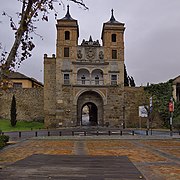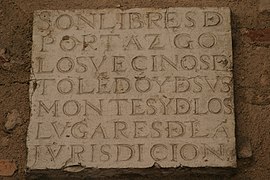
Toledo is a city and municipality of Spain, the capital of the province of Toledo and the de jure seat of the government and parliament of the autonomous community of Castilla–La Mancha.
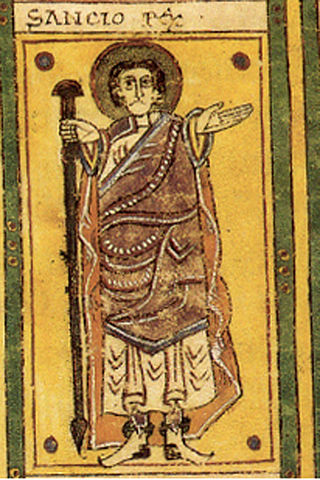
Sancho Garcés II, also known as Sancho II, was King of Pamplona and Count of Aragon from 970 until his death in 994. He was the eldest son of García Sánchez I of Pamplona and Andregoto Galíndez. He recognised the Kingdom of Viguera during his reign.

The Puerta de Alcalá is a Neo-classical gate in the Plaza de la Independencia in Madrid, Spain.
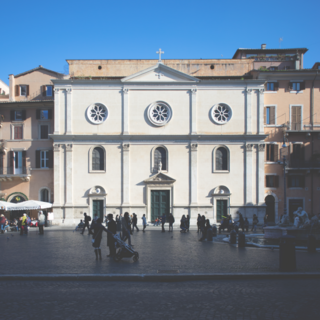
Nostra Signora del Sacro Cuore is a Catholic church dedicated to the Virgin Mary located in Rome's Piazza Navona.

The Puerta del Puente is a Renaissance gate in Córdoba, Andalusia. Built in the 16th century to commemorate a visit to the city by King Philip II, the gateway is located on the site of the previous Roman gates, linking the city with the Roman bridge and the Via Augusta.

The 1918 Copa del Rey Final was an association football match between Real Unión and Madrid FC on 12 May 1918, at the O'Donnell Stadium in Madrid. It was the deciding match of the Spanish cup competition, the Copa del Rey. Real Unión beat Madrid FC 2–0 to win their first title. Unión's captain, forward Juan Legarreta, scored both goals. The final was attended by approximately 10,000 spectators.
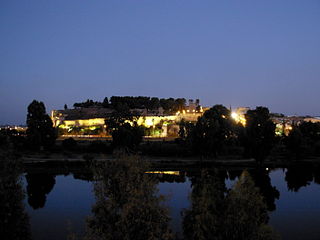
The Alcazaba of Badajoz is an ancient Moorish citadel in Badajoz, Extremadura, western Spain. The alcazaba as it now appears was built by the Almohads in the 12th century, although it probably existed from the 9th century, when Badajoz was founded. In the 11th and 12th centuries it was the residence of the rulers of the taifa of Badajoz.

Puerta de Hierro is a monument of the second half of the 18th century, located in the northwest of Madrid, Spain, in the district of Moncloa near the Monte de El Pardo. It occupies a landscaped traffic island, defined by several branches of the highway A-6 and M-30, an enclave which is difficult to access. It is built in classical Baroque style.
Francisco Hernández Tomé was a Spanish mural painter who decorated the interiors of many churches and theatres in Madrid.

The Walls of Felipe IV surrounded the city of Madrid between 1625 and 1868. Philip IV ordered their construction to replace the earlier Walls of Philip II and the Walls del Arrabal, which had already been surpassed by the growth of population of Madrid. These were not defensive walls, but essentially served fiscal and surveillance purposes: to control the access of goods to the city, ensure the collection of taxes, and to monitor who went in and out of Madrid. The materials used for construction were brick, mortar and compacted earth.

The Walls of Madrid are the five successive sets of walls that surrounded the city of Madrid from the Middle Ages until the end of the 19th century. Some of the walls had a defensive or military function, while others made it easy to tax goods entering the city. Towards the end of the 19th century the demographic explosion that came with the Industrial Revolution prompted urban expansion throughout Spain. Older walls were torn down to enable the expansion of the city under the grid plan of Carlos María de Castro.

The Muslim Walls of Madrid, of which some vestiges remain, are located in the Spanish capital city of Madrid. They are probably the oldest construction extant in the city. They were built in the 9th century, during the Muslim domination of the Iberian Peninsula, on a promontory next to Manzanares river. They were part of a fortress around which developed the urban nucleus of Madrid. They were declared an Artistic-Historic Monument in 1954.
The Christian Walls of Madrid, also known as the Medieval Walls, were built in Madrid, Spain between the 11th and 12th centuries, once the city passed to the Crown of Castile. They were built as an extension of the original 9th-century Muslim Walls of Madrid to accommodate the new districts which emerged after the Reconquista.
The Walls del Arrabal were the third in a set of five walls built around Madrid, now the capital of Spain. There are no remaining ruins of the Walls del Arrabal, leaving some debate as to their extent and the period of their construction. It is possible that the walls were built as early as the 12th century, however they were most likely constructed in 1438. The walls may have been intended to protect people against the plagues that ravaged the city at the time. The walls united the urbanized suburbs of the city and prevented entry of the infected.

The Walls of Philip II were walls in the city of Madrid that Philip II, in 1566, constructed for fiscal and sanitary control. The walls enclosed an area of about 125 ha.
The following is a timeline of the history of the city of Toledo, Spain.

The Alarcones Gate is a city gate located in the city of Toledo, in Castile-La Mancha, Spain. It is also known by the name of Puerta de Moaguía, as cited in Mozarabic documents of 1216; and Puerta Alta de la Herrería, because it is located at the end of the street where workshops dedicated to ironworks were located.

The Puerta del Vado is a city gate built between the late-11th and early-12th centuries and located in the neighborhood of Antequeruela in the city of Toledo,. This district was known before and after the reconquest of the city of Toledo like the arrabal of San Isidoro, an area of important potter tradition.

The Puerta de San Andrés is a city gate in Segovia, Castile and León, Spain, forming part of the city's medieval fortifications. It is listed as a Bien de Interés Cultural.

